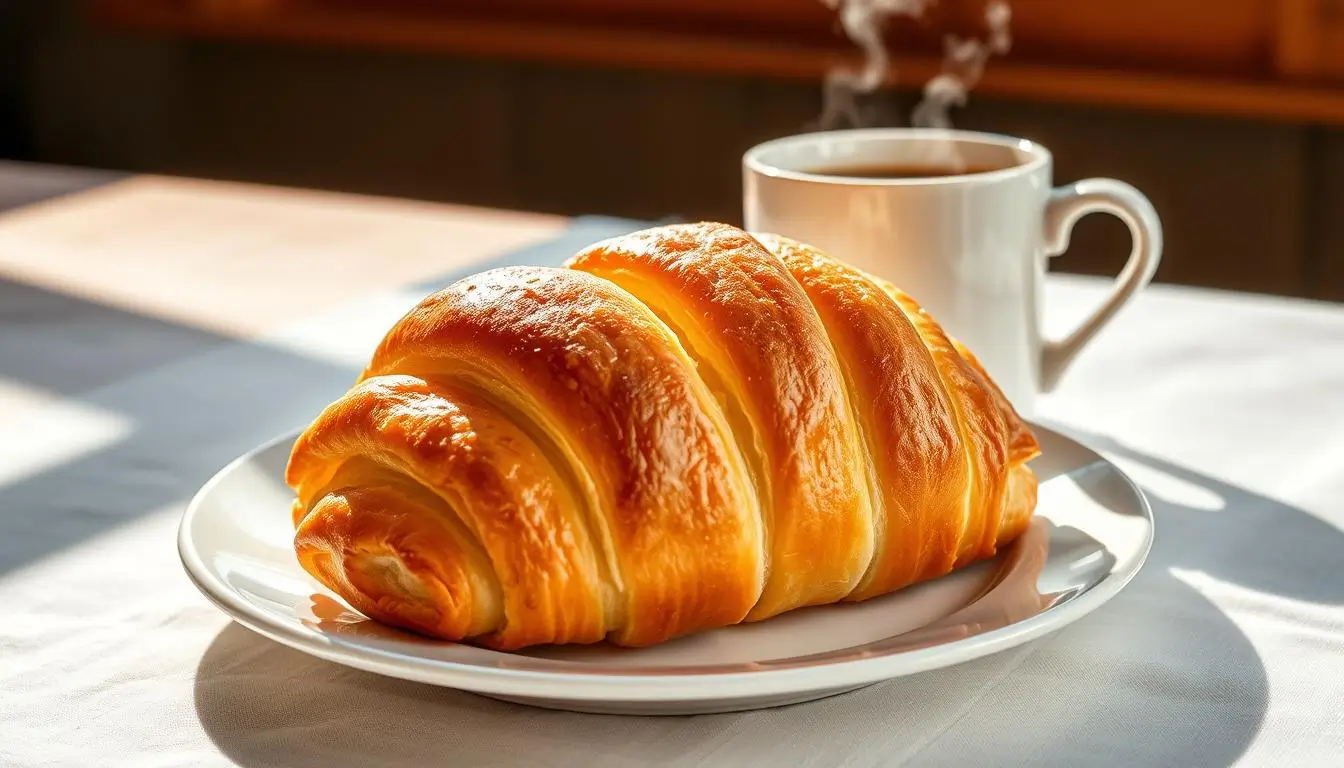Imagine the sound of a golden pastry crunching and the smell of butter filling your kitchen. That’s the magic of Swiss Gipfeli, a swiss pastry recipe loved in alpine villages for years. It’s a flaky, slightly less buttery cousin of croissants, just as deserving of your baking time.
Looking for a croissant alternative for breakfast or a weekend project? This gipfeli recipe is perfect. Picture enjoying a crescent-shaped treat that’s all about tradition and texture. It’s a delicate mix of crisp layers and soft crumb, great with coffee or fillings like almond paste or Nutella. It’s more than a pastry—it’s a piece of Swiss culture you can make at home.
Table of Contents
What Are Gipfeli and Why They’re Special
Learn about the history of homemade gipfeli, a key part of Swiss cuisine since the 1600s. These crescent-shaped treats are more than just food; they’re a cultural icon. They’re a favorite on breakfast tables in Europe, with a special Swiss touch.

The Signature Characteristics of Authentic Gipfeli
Every bite has a story:
- Golden flaky layers from butter-laminated dough
- Sweetness from sugar and yeast-infused dough
- Triangular shape rolled into a tight spiral
- Texture balancing crisp crust with tender interior
Gipfeli vs. Croissants: Key Differences
What makes them unique?
- Sweeter flavor profile with sugar in the dough
- Less airy than croissants, with denser layers
- Swiss origins vs. French croissant traditions
- Shaped into triangles instead of full crescents
The Cultural Significance in Swiss Cuisine
Gipfeli have deep roots in Swiss kitchens, dating back to the 1600s. They’re not just breakfast; they’re a family tradition. In Switzerland, families enjoy them warm with coffee. Each region has its own twist, like Valais’ almond-stuffed Mandelgipfel.
The History Behind Traditional Swiss Gipfeli
Switzerland’s love for traditional swiss recipes is clear in its iconic Gipfeli. This flaky pastry has been a breakfast favorite since the 19th century. It’s rooted in Swiss baking traditions.
Unlike the French croissant, which started in Paris in 1837, Gipfeli grew in Swiss homes and bakeries. Its name comes from the Alemannic term for crescent-shaped pastries. This shows its unique place in swiss cuisine.
Early Gipfeli recipes used simple ingredients like flour, butter, and sugar. Bakers perfected lamination techniques to create layers without machines. Sourdough starters, still loved today, were key in early recipes.
By the late 1800s, Gipfeli became a symbol of community baking. It was often shared during holidays like Christmas and Fasnacht (carnival).
Today, Gipfeli connects us to tradition. Families share methods like folding dough 6–8 times for flakiness. Even with gluten-free trends, many Swiss bakeries like Zum Löwen in Zurich stick to old ways. This shows Gipfeli’s lasting role in swiss cuisine.
Learning about Gipfeli’s history makes baking it special. It’s not just a recipe—it’s a link to Swiss bakers through generations.
Essential Ingredients for Your Gipfeli Recipe
Mastering the gipfeli recipe begins with the right ingredients. These ensure your pastry has the Swiss texture and taste. Let’s look at each part of the dough and filling:
Choosing the Right Flour for Perfect Texture
For the best tenderness, use 4 cups (500g) of all-purpose flour. European flours like Muhle Dinkelsbühl have more protein. This makes the dough strong without being too thick. For gluten-free, mix ⅔ cup rice flour with ⅓ cup potato starch, but results may differ.
Butter Selection: The Key to Flaky Layers
- Choose ¾ cup (170g) of cold European-style butter, like Kerrygold or Plugrá, for flakiness.
- Butter with 82%+ butterfat keeps the dough from shrinking during lamination.
- Save 1 tbsp softened butter for brushing before baking.
Additional Ingredients and Possible Substitutions
The basic mix needs:
- 2½ tsp instant yeast (or 7g fresh yeast) to make it rise.
- 2 tbsp sugar and ½ tsp salt for taste.
- 1 cup warm milk (43°C/110°F) to start the yeast.
You can add cinnamon or almond filling, or try lemon zest or chocolate for a twist. Vegans can use oat milk and dairy-free butter, but it won’t be as flaky.
Pro tip: Measure flour by spooning and leveling to avoid dry dough. For 12 pastries, make sure all ingredients are at room temperature before mixing.
Step-by-Step Guide to Making Homemade Gipfeli
Learn how to make gipfeli with this simple guide. Begin by mixing 1 cup of lukewarm milk (105–115°F), 40–46°C), 2 tbsp sugar, and 1 packet of instant yeast. Wait 5 minutes for it to become foamy. Then, add 4 cups of all-purpose flour, 1½ tsp salt, and knead until it’s smooth.
Cover it and let it rise for 1 hour until it doubles in size.
- Roll the dough into a ¼-inch thick rectangle. Spread 200g of cold unsalted butter (sliced into ½-inch pieces) over two-thirds of the dough. Fold it like a letter, then chill for 30 minutes.
- Roll it again to ⅛-inch thickness. Fold it into three layers, turn 90°, and chill. Repeat this homemade gipfeli folding process twice more for flaky layers.
- Shape into crescents by rolling dough into ropes, twisting ends. Place on parchment-lined sheets 1 inch apart. Brush with egg wash and let proof for 30 minutes.
- Bake at 375°F (190°C) for 15–20 minutes, or until golden. Cool on a rack before serving.
Enjoy these Swiss pastries with coffee for a classic breakfast idea. Store leftovers in an airtight container for 2 days or freeze for later. Reheat at 350°F (175°C) for 5 minutes. Try fillings like almond paste or cinnamon sugar for a twist.
Mastering the Perfect Fold and Shape
Creating authentic Swiss Gipfeli means perfect layers and shape. Use precise techniques to get that flaky texture in your pastry recipes. Begin by rolling chilled dough into a 3–4mm thick circle. This is crucial for even baking.
The traditional folding method is similar to puff pastry recipes. But it’s simpler. It creates layers that make your pastry flaky.
The Traditional Swiss Folding Technique
Start by folding the dough like a letter. Fold one-third of the circle inward, then fold the opposite third over it. This makes layered pockets.
After chilling, roll it out again to form 3–4mm triangles. To make how to make gipfeli crescents, roll each triangle tightly from the base to the tip. Use gentle pressure to seal edges without crushing layers.
Common Shaping Mistakes to Avoid
- Over-stretching dough stretches layers thin, reducing flakiness.
- Ignoring temperature—cold butter must remain solid during folding.
- Skipping final proofing shortens rise time, leading to dense pastry.
Visual Guide to Proper Formation
Each step should show crisp edges and smooth curves. Final crescents should have visible folds but no cracks. Check dough flexibility: it should bend without tearing.
Proper shaping ensures a 20–28 minute bake yields golden, airy results. Practice builds precision—this skill elevates homemade pastry recipes into restaurant-quality treats.
Baking Tips for Achieving Golden, Flaky Pastry
First, preheat your oven to 180°C (350°F). Place racks in the center. Before baking, brush each easy breakfast pastry with a light egg yolk and milk mix. This gives them a glossy, golden look.
Set your timer for 15-18 minutes. This time is perfect for getting them just right. Don’t open the oven too soon, as it can dry them out. Check if they’re done by looking at the edges and the inside temperature.
For even baking, rotate the pan halfway. This ensures all sides get the same heat.
- Rest dough 15 minutes after shaping to relax gluten and prevent shrinkage.
- Use parchment paper to prevent sticking without losing crispiness.
- Let pastries cool completely on a wire rack to avoid sogginess.
If you’re reheating leftovers, warm them at 180°C (350°F) for 5–10 minutes. Store any uneaten Gipfeli in an airtight container for up to 2 days. Or, freeze them for longer. For the best texture, bake frozen pastries at 180°C (350°F) for 15 minutes.
Try different fillings like almond paste or cheese-spinach mix. But make sure they’re spread evenly before rolling.
Remember, timing and temperature are crucial. If butter is too cold, it cracks the layers. If it’s too warm, the dough stretches too much. Let it sit at room temperature for 10 minutes before folding. Patience in the lamination steps is key to achieving flaky layers.
Conclusion: Enjoying Your Freshly Baked Swiss Gipfeli
Now that your Gipfeli are baked, enjoy them warm as a satisfying centerpiece for weekend brunch recipes. Serve them plain for a buttery bite or try fillings like apricot jam, dark chocolate shavings, or savory ham and Swiss cheese. Pair each pastry with a steaming cup of coffee or herbal tea to mirror Swiss morning traditions.
For busy mornings, these easy breakfast pastries store well at room temperature for two days. Freeze unbaked dough for up to three months—simply thaw and bake for 18–20 minutes for fresh results. A single serving offers 250 calories with 30g of carbohydrates, making them a hearty yet manageable option for breakfast ideas.
Try creative twists like cinnamon-sugar toppings or almond extract in the dough. The 3-fold laminating technique ensures layers that rival croissants, but with simpler steps. Share batches with friends during weekend gatherings, showcasing their flaky texture and cultural roots.
Whether enjoyed as a weekend treat or a quick weekday breakfast, Gipfeli adapt to any meal. Their 12-inch rolled dough accommodates both sweet and savory flavors, proving they’re more than just a Swiss tradition—they’re a versatile pastry solution. Bake them as a weekend project, then savor the results across days thanks to their durable texture and flavor retention.

